Extreme sensitivity to the ultraviolet rays can lead to the development of red-colored, itchy rashes on the skin within minutes. It is important to note that sun poisoning which is medically known as polymorphous light eruption usually manifests in the form of small-sized papules and less commonly as plaques on the exposed parts of the skin.
Even though the amount of ultraviolet exposure that causes sun rash tends to vary depending on the individual, most individuals have a minimum threshold on how long they can be exposed to the ultraviolet rays before the rash erupts. Sun poisoning can resolve on its own within a few days or weeks and does not require medical care. Home treatment options and prevention measures can greatly help in managing sun rashes. If you want to learn more about these treatment options, read here.
Topical treatment for sun rash

If an individual sustained sun rash, you have to apply a cold compress over the affected area using a towel moistened with cool water. An over-the-counter hydrocortisone cream can help relieve the itchiness but if a natural route is chosen, it is suggested to apply a soothing topical aloe vera gel over the area that is affected by the sun rash.
Oral remedies for sun rash
The ideal way to reduce the pain and redness due to sun rash is to provide the individual with aspirin or ibuprofen. It is suggested to use an herbal anti-inflammatory or 2-3 grams of fish oil every day to help minimize the inflammation linked with sun rash.
Protection against the sun
It is important to avoid direct exposure to the sun. This is the ideal protection against sun rash and it also includes avoiding the use of sun lamps and tanning beds as much as possible. If the individual has to go outdoors, it is recommended to apply sunscreen that offers sun protection factor (SPF) minimum of 15 at least 20 minutes before going outside. Do not forget to apply sunscreen since this is vital in protecting the skin from the rays of the sun.
The individual should always bring the sunscreen and reapply it every 2 hours. It is also recommended to wear tightly-woven clothing that covers the legs and arms as well as wearing a wide-brimmed hat every time the individual goes outdoors. Additionally, bringing along an umbrella can also provide protection.
If possible, the individual should stay out of direct exposure to the sun when the ultraviolet rays are at its highest usually between 11AM to 3PM. Another approach is to avoid the rays of the sun between 10AM to 2PM particularly during April up to September. Take note that the most conservative measure in order to prevent the development of sun rashes is to stay indoor between 10AM up to 4PM.
